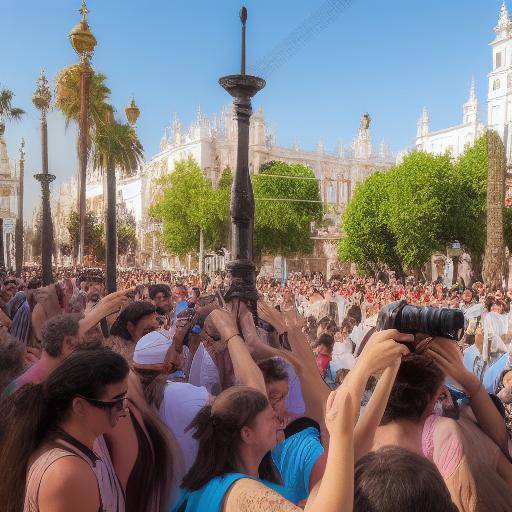
The Holy Week in Seville is one of the most emblematic and entrenched celebrations of Andalusian tradition. Their rituals, processions and cultural significance have fascinated people from all over the world. In this article, we will explore the rich religious and traditional history that envelops this festival, analyze in depth its roots and evolution, as well as compare and contrast Holy Week, Andalusian tradition and religious history, providing practical advice and predictions on future trends. Join us on this fascinating journey through the Sevillian Holy Week!
Introduction
Easter is more than a week of holiday and tradition in Seville; it is a celebration that collects centuries of history, faith and devotion. During this time, the city becomes an impressive setting where the sisterhoods, with their imposing steps, captivate locals and visitors. In this article, we will unveil the secrets after the Holy Week in Seville, from its humble origins to the excruciating current processions.
History and Background
The history of Holy Week is intertwined with the origins of Christianity on the Iberian peninsula. It dates back to the time of Roman domination in Hispania, when Christianity was persecuted and repressed. However, the faith of the early Christians persisted, rooting in the region and giving rise to the first manifestations of Holy Week.
During the Arab domination, the celebration of Holy Week was restricted, but it rose strongly with the Reconquest, consolidating itself as one of the most important traditions of Andalusia. Over the centuries, Holy Week has been transformed, merging religious, cultural and artistic elements that have made it a unique event in the world.
The evolution of the Sevillian Holy Week has been marked by significant milestones, such as the foundation of the hermands, the creation of the famous procesional images and the expansion of popular devotion. Each step, every Nazarene and every arrow tuned during the procession carry with it a historical and emotional burden that transcends time.
Analysis in Deep
Holy Week in Seville is a major cultural and religious phenomenon. It offers countless benefits, both in terms of tourism and the preservation of traditions. However, it also faces challenges, such as crowd management and the preservation of its authenticity in a modern context. Today, sisterhoods and brotherhoods have adopted innovative strategies to preserve the essence of Holy Week, combining tradition with technology and sustainable management.
Exhaustive examination
The Holy Week in Seville, as an integral part of Andalusian tradition and religious history, has been the subject of numerous analyses and studies. Combining faith, art and culture, this event is a fertile field for exploring best practices in terms of organization, management and promotion. The lessons learned from the Sevillian Holy Week contain valuable lessons applicable to other areas, from event planning to the promotion of cultural heritage.
Comparative analysis
When we compare Holy Week, Andalusian tradition and religious history, we find the intersection of elements that mutually enrich their meaning. Traditions are intertwined with religious practices, generating a unique symbiosis that highlights the cultural diversity and spirituality of the region.
Practical Tips and Accessible Advice
If you plan to experience Easter in Seville, it is important to be well prepared. Be sure to book in advance, familiarize yourself with the dates of the main processions and consider joining guided tours to get a deeper understanding. In addition, it respects the sacred character of rituals and shows due respect for participants.
Perceptions of Industry and Expert Reviews
Several outstanding personalities, including historians, anthropologists and religious leaders, have shared their perceptions of Holy Week in Seville. Their views provide an enriching perspective on the cultural and spiritual importance of this festival, as well as on the challenges and opportunities it faces today.
Case Studies and Practical Applications
Throughout the centuries, the Holy Week in Seville has left a profound mark on the lives of people. By exploring specific cases, from the restoration of religious images to the economic impact in the region, we can better understand how these traditions have shaped collective identity and social development.
Future Trends and Predictions
As society evolves, the Holy Week in Seville will continue to adapt to the changes. Predictions on the integration of emerging technologies, the sustainability and participation of new generations shed light on the future of this celebration, stressing the importance of preserving its legacy while embraced by innovation.
Conclusions
Holy Week in Seville embodies the very essence of Andalusian tradition and religious history. Through its rituals, processions and artistic manifestations, this celebration has endured over the centuries, rooting in the heart of the community. As a witness to history and faith, Holy Week enriches human experience, reminding us of the importance of devotion, art and solidarity.
Frequently asked questions
What is the origin of Holy Week in Seville?
The Holy Week in Seville has its roots in the religious history of the region, rejoining the time of Roman domination and reaching its splendor during the Reconquest.
What are the most representative elements of the Sevillian Holy Week?
The most representative elements are processions, religious images, arrows, and the active participation of sisterhoods and brotherhoods.
What is the economic impact of Holy Week in Seville?
Easter is an important economic engine for the city, attracting a large number of tourists and generating significant income for the tourist and commercial sector.
How does the city prepare for Holy Week?
The preparation of the city includes the coordination of the different brotherhoods and brotherhoods, the planning of the processions routes, and security measures to ensure the orderly development of the events.
Why is Holy Week in Seville considered an Intangible Cultural Heritage of Humanity?
UNESCO recognized Holy Week in Seville as an Intangible Cultural Heritage of Humanity due to its importance as an expression of faith, artistic creativity and social cohesion.
What is the meaning of the arrows in Holy Week?
The arrows are songs of a religious nature that are tuned during the processions as an expression of devotion and touching artistic manifestation.
In short, the Holy Week in Seville is much more than a religious celebration; it is a symbol of identity, collective memory and devotion. Through this journey through its history, rituals and cultural significance, we hope to have provided an enriching vision of this unique holiday in the world.



